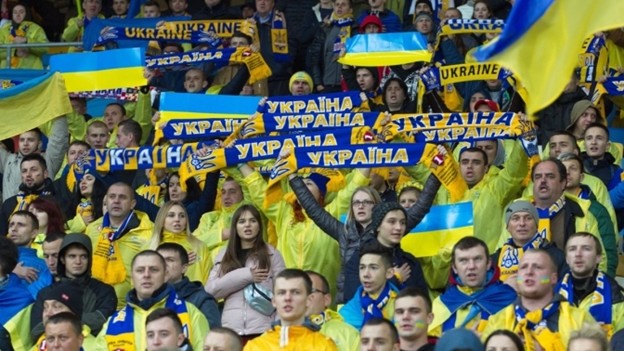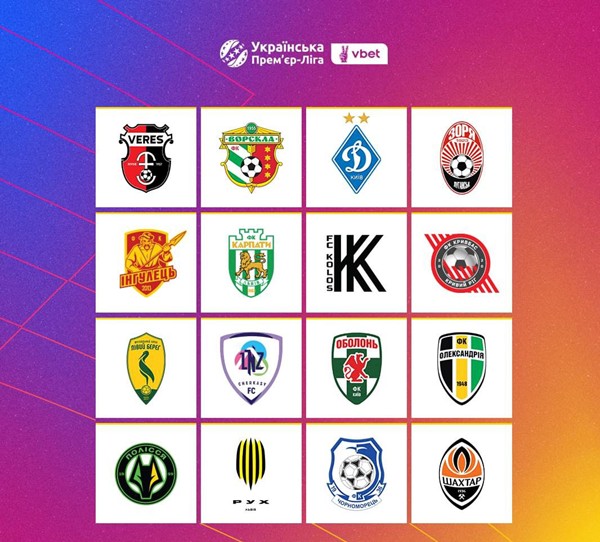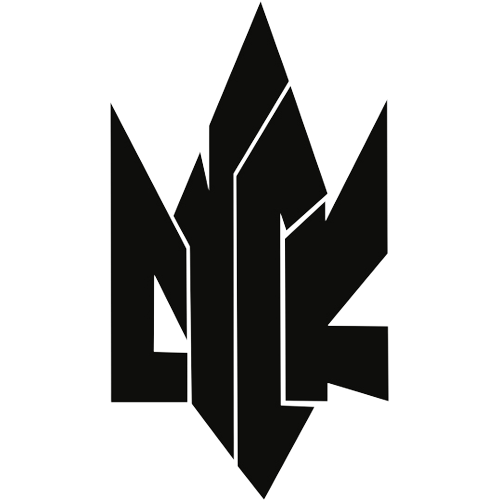Written by SUSK Canada Summer Job Intern – Daniil Zhelezniak (Saint Mary’s University)
Football is the most popular sport in most countries of the world and Ukraine is no exception in this case; here, this game is a cultural phenomenon closely related to the social structure of the country. While the world’s fans may be primarily thinking of the superstar striker Andriy Shevchenko, who played in Italy and England, the Ukrainian football legacy runs much deeper. Football in Ukraine has had historical triumphs of clubs, the glory of youth teams, and the resilience of this sport and its fans during the war, demonstrating the public spirit and indomitable will to win. This article explores Ukrainian football at home and abroad, the state of the leagues, and the rise of the women’s game within Ukraine’s unique football culture.
National Team Pride and Youth Success
Football remains the most popular sport in Ukraine by a wide margin: approximately 72% of Ukrainians showed interest in it, and 68% watched live matches quite regularly before the full-scale invasion (later this figure dropped to 45%) (“The Gradus”, 2022). In the highly successful 2012/13 season, the top Ukrainian league attracted more than 3 million supporters at 230 matches, with an average attendance of almost 12,600 fans per game (“УПЛ побила рекорд відвідуваності”, 2013). The main team of Ukraine and its identity is undoubtedly the men’s national team (nickname: the blue and yellow), which ranks 26th in the FIFA global ranking, which is the highest result among the national teams of the former Soviet republics (“FIFA/Coca‑Cola Men’s World Ranking”, 2025). At its first (and so far only) World Cup since independence, in 2006, Ukraine achieved its highest result by reaching the quarterfinals, then reaching this stage again only at the 2020 European Championship (which was held in 2021). Another significant achievement of Ukrainian football and sports in general is the hosting of the 2012 European Championship, where Ukraine, together with Poland, demonstrated to the world its enthusiasm, high-quality organization, infrastructure, and hospitality of cities such as Kyiv, Donetsk, Kharkiv, and Lviv. Moreover, Euro 2012 helped to open Ukraine up to the world, attract guests, and, most importantly, dispel the long-cultivated negative stereotypes in the Western media about Ukraine by hosting a major international tournament and filling the streets with celebrating fans with blue and yellow flags, showing national pride (Yelisieiev, 2012).
The performance of the youth national teams of Ukraine was no less impressive, which indicates excellent talent training. In 2009, the Ukrainian national under-19 team, playing on home soil in Donetsk and Mariupol, defeated England in the final and won the European Championship title in front of 25,000 cheering spectators (“Euro‑2009 (U‑19): Ukraine’s triumph!”, 2009). It was the first time that any of the host countries had won the European Under-19 Championship. And relatively recently, in 2019, the Ukrainian U20 national team (in fact, the U19 graduates) stunned the world by winning the FIFA U-20 World Cup, beating South Korea in the final and winning the first world championship title in Ukraine (Sorokin, 2019). In fact, teenagers who have just won the youth championships become national heroes overnight, such achievements of the junior teams have given strength, revived interest for Ukrainian fans. These successes also have deep cultural significance and highlight the best features of the people, as sport is often seen as a mirror of the spirit of Ukraine: perseverance, optimism, unity, and achievement of high results.

Legendary Clubs and Their Achievements
Club football and its top division, the Ukrainian Premier League, also occupy an important place in the life of the country, for decades, it has attracted the attention of both fans and the richest Ukrainians (often oligarchs), such as Rinat Akhmetov, Igor Surkis, Igor Kolomoisky, and others (Gaponenko, 2017). So, Dynamo Kyiv, led by iconic coach Valeriy Lobanovskyi, was a trailblazer in European football — winning two European Cup Winners’ Cups (1975, 1986), the UEFA Super Cup, and producing three Ballon d’Or (The best player in the world) winners: Oleg Blokhin, Igor Belanov, and Andriy Shevchenko (Linnyk, 2016). Also in Soviet times, Dynamo became a people’s team that inspired and united Ukrainians by successfully competing with Moscow teams, having won the most USSR titles (Jensen, 2022). Rival Shakhtar Donetsk, owned by Akhmetov, rose to global prominence in the 2000s, powered by top-tier infrastructure like the Donbas Arena and a core of talented Latin American players, their historic 2009 UEFA Cup victory marked a new era for Ukrainian clubs in Europe (Forrest, 2015).
There are also other legendary teams that shaped independent Ukraine’s football landscape, such as Dnipro Dnipropetrovsk, runners-up in the 2015 UEFA Europa League (UEFA Cup); Metalist Kharkiv – 2012 Europa League quarter-finalists; and major clubs like Chornomorets Odessa, Karpaty Lviv, Vorskla Poltava, Arsenal Kyiv, Kryvbas Kryvyi Rih, Zorya Lugansk, which caused a major sensation in the Soviet league of 1972, and Tavriya Simferopol, the first champions of independent Ukraine in 1992. Unfortunately, some of these clubs have been dissolved due to financial collapse or the effects of war and occupation (Jones, 2019). Yet their legacy lives on in the hearts of fans, many of whom are defending their country at the front lines.

Resilience on the Pitch: Football During the War
Ukrainian football has experienced huge upheavals due to the war, as Russia’s illegal actions in Crimea and Donbas in 2014 marked the beginning of a turbulent era that included not only territorial losses but also great pressure on the country’s economy and infrastructure. So, the Crimean clubs were disbanded, and the clubs of eastern Ukraine were forced to move — Shakhtar left its ultramodern Donbass Arena, moving matches to cities such as Lviv, Kharkiv, Kyiv, while Zorya settled in Zaporizhia (Fish, 2025). Due to the loss of important economic and industrial centers, capital outflow, and economic fluctuations, from 2014 to the present day, Ukrainian football has been undergoing a process of changing the activities of team owners, with more modest agricultural organizations replacing industrial billionaires (Kirichenko & Todos, 2024). Despite the drop in the level, as indicated by the UEFA coefficient table and the budgets of the teams, the Ukrainian Premier League has adapted, and the Ukrainian fans have united, despite the historical rivalry (“UEFA rankings – Associations (men’s)”, 2025). The full-scale Russian invasion in 2022 brought football to the brink of disaster, putting it on pause, however, by August 2022, under martial law and with the presence of air raids, the league resumed its work in relatively safe regions (Morse & Foster, 2022). The games were played behind closed doors, with interruptions for missile alarms, and the matches were streamed online or viewed during power outages using generators, which gave hope to fans across Ukraine. Ukrainian clubs and the national team continued to compete in European tournaments, hosting matches in Poland, Slovakia, Germany, and Romania due to security concerns. Shakhtar Donetsk and Dynamo Kyiv remain the dominant players in the league, while youth academies are being rebuilt due to limited conditions, some players are returning from abroad, and clubs rely on UEFA and FIFA charitable foundations to survive. Football in Ukraine has become more than just a game — it is a symbol of resistance, unity, mutual assistance, and hope, as the legendary football player Andriy Shevchenko said: “participating in a major tournament during a full-scale war is a powerful opportunity to remind the world of Ukraine’s struggle” (Kunti, 2024). Today, football continues to reflect this spirit, proving over and over again that Ukraine, despite great difficulties and losses, is alive (Whitehead, 2024).

The Rise of Women’s Soccer in Ukraine
However, there have been positive trends in Ukrainian soccer in recent years, particularly, women’s sports in Ukraine have achieved significant success. The Ukrainian Association of Football launched a 2020–2024 strategy to grow the women’s game, focusing on academy programs and league development (Feringa, 2024). Top men’s clubs like Shakhtar and Dynamo have since added women’s teams, and the Ukrainian Women’s League is now firmly established, while clubs have competed in UEFA Women’s Champions League, signaling rising quality. This growing government support and recognition help to break down gender stereotypes, which is important not only to increase the diversity of Ukraine’s sports culture but also to reflect its broader commitment to gender equality as part of European integration.

Conclusion: More Than Just a Game
After all, football in Ukraine is much more than just a sport, it is a living part of the country’s cultural heritage and a reflection of the interests of the people. Football continues to unite Ukrainians, inspire pride and reflect the spirit of a nation determined to survive and prosper, from the historical rivalry of the clubs to the development of women’s football and the difficulties associated with the game during the war. Participating in international tournaments in such difficult times not only brings joy to the whole country, but also helps Ukrainians feel connected to the international community, which is an extremely important source of dignity and solidarity. These achievements bring positive emotions to fans all over the country and even motivate military personnel, reminding everyone that Ukraine is alive, strong and unbroken.
References
Dendak, M. (2025, May 27). Ukraine national football team’s 2025 match calendar. Champion. https://champion.com.ua/ukr/football/kalendar-matchiv-zbirnoji-ukrajini-z-futbolu-na-2025-rik-1037818/
Euro‑2009 (U‑19): Ukraine’s triumph!. (2009, August 2). FC Dynamo Kyiv. Retrieved from https://fcdynamo.com/en/news/euro_2009_u_19_ukraine_s_triumph#:~:text=Ukraine’s%20Under%2D19%20team%20have,front%20of%20over%2025%2C000%20fans.
Feringa, M. (2024, November 5). ‘Rockets from Russia to Poltava, 30 seconds’ – life as a female footballer in Ukraine. NY Times. Retrieved from https://www.nytimes.com/athletic/5879583/2024/11/05/ukraine-women-vorskla-poltava-war/
FIFA/Coca‑Cola Men’s World Ranking. (2025, July 10). FIFA. Retrieved from https://inside.fifa.com/fifa-world-ranking/men
Fish, H. (2025, February 25). Donbas Arena Unrecognisable After Being Abandoned in 2014, Give Me Sport. Retrieved from https://www.givemesport.com/donbas-arena-is-completely-unrecognisable/
Forrest, B. (2015, October 15). Shakhtar fights to survive in the UCL, but its owner is in even more peril. ESPN. Retrieved from https://www.espn.co.uk/football/story/_/id/37432222/the-story-shakhtar-donetsk-owner-rinat-akhmetov
Gaponenko, O. (2017, October 13). Кому належать українські клуби: олігархи, офшори, вбитий кримінальний авторитет. Football24.ua. Retrieved from https://football24.ua/ru/komu_nalezhat_ukrainski_klubi_oligarhi_ofshori_vbitij_kriminalnij_avtoritet_n411343/
Jensen, N.F. (2022, March 7). Ukraine was the engine of USSR football. Game of The People. Retrieved from https://gameofthepeople.com/2022/03/07/ukraine-was-the-engine-of-ussr-football/
Jones, B. (2019, March 14). The fall of FC Dnipro from the 2015 Europa League final to the amateur leagues. These Football Times. Retrieved from https://thesefootballtimes.co/2019/03/14/the-fall-of-fc-dnipro-from-the-2015-europa-league-final-to-the-amateur-leagues/
Kirichenko, D. & Todos, A. (2024, November 1). Game on: How football survives in wartime Ukraine. Euromaidan Press. Retrieved from https://euromaidanpress.com/2024/01/11/game-on-how-football-survives-in-wartime-ukraine/
Kunti, S. (2024, June 26). Andriy Shevchenko Stresses Importance Of Euro 2024 To Ukrainian Cause. Forbes. Retrieved from https://www.forbes.com/sites/samindrakunti/2024/06/26/andriy-shevchenko-stresses-importance-of-euro-2024-to-ukrainian-cause/
Linnyk, I. (2016, July 31). In profile: Valeriy Lobanovskiy. UEFA.com. Retrieved from https://pt.uefa.com/uefachampionsleague/news/0253-0d81cad2bd33-25a62e3a110f-1000–in-profile-valeriy-lobanovskiy/
Morse, B & Foster, M. (2022, August 25). Ukrainian Premier League match halted four times by air raid sirens and takes over four hours to complete. CNN. Retrieved from https://www.cnn.com/2022/08/25/football/ukraine-air-raid-rukh-lviv-metalist-kharkiv-spt-intl
Sorokin, O. (2019, June 15). Ukraine’s national youth soccer team wins 2019 FIFA U20 World Cup. Kyiv Post. Retrieved from https://archive.kyivpost.com/sport/ukraines-national-youth-soccer-team-wins-2019-fifa-u20-world-cup.html
The Gradus Research. (2022, September 12). Football is the most popular sport for Ukrainians, according to the results of the Gradus study. 1+1 Media. Retrieved from https://media.1plus1.ua/en/news/futbol__naipopuliarnishyi_vyd_sportu_dlia_ukraintsiv__rezultaty_doslidzhennia_gradus
Today, Lviv hosts match of the Ukraine national team against Bosnia and Herzegovina — where to watch it online. (2021, October 12). Tvoe Misto. Retrieved July 22, 2025, from https://tvoemisto.tv/news/sogodni_u_lvovi_vidbudetsya_match_zbirnoi_ukrainy_z_bosniieyu_i_gertsegovynoyu_de_dyvytysya_onlayn_124022.html
UEFA rankings – Associations (men’s). (2025, July 22). UEFA.com. Retrieved from https://www.uefa.com/nationalassociations/uefarankings/country/?year=2026
UPL 2025–2026: Full list of participants. (2025, June 1). RENEWS. Retrieved July 22, 2025, from https://renews.com.ua/sport/ypl-2025-2026-povnii-spisok-ychasnikiv/
Whitehead, J. (2024, June 21). Ukraine prove their football is alive: ‘The strong man is the one who can get back up’. NY Times. Retrieved from https://www.nytimes.com/athletic/5581789/2024/06/21/ukraine-euro-2024-russia-war/
Women’s Vyshcha Liha: Kolos defeated Lviv’s Karpaty 2–0. (2021, October 10). Kolos Kovalivka. Retrieved from https://koloskovalivka.com/en/news/zhinki-vishcha-liga-kolos-peremig-lvivski-karpati-2-0
Yelisieiev, K. (2012, July 2). Euro 2012: Five lessons learned in Ukraine. EURACTIV. Retrieved from https://www.euractiv.com/section/global-europe/opinion/euro-2012-five-lessons-learned-in-ukraine/
УПЛ побила рекорд відвідуваності. (2013, June 2). Sportanalytic. Retrieved from https://sportanalytic.com/football/137243upl-pobila-rekord-vidviduvanosti.html

